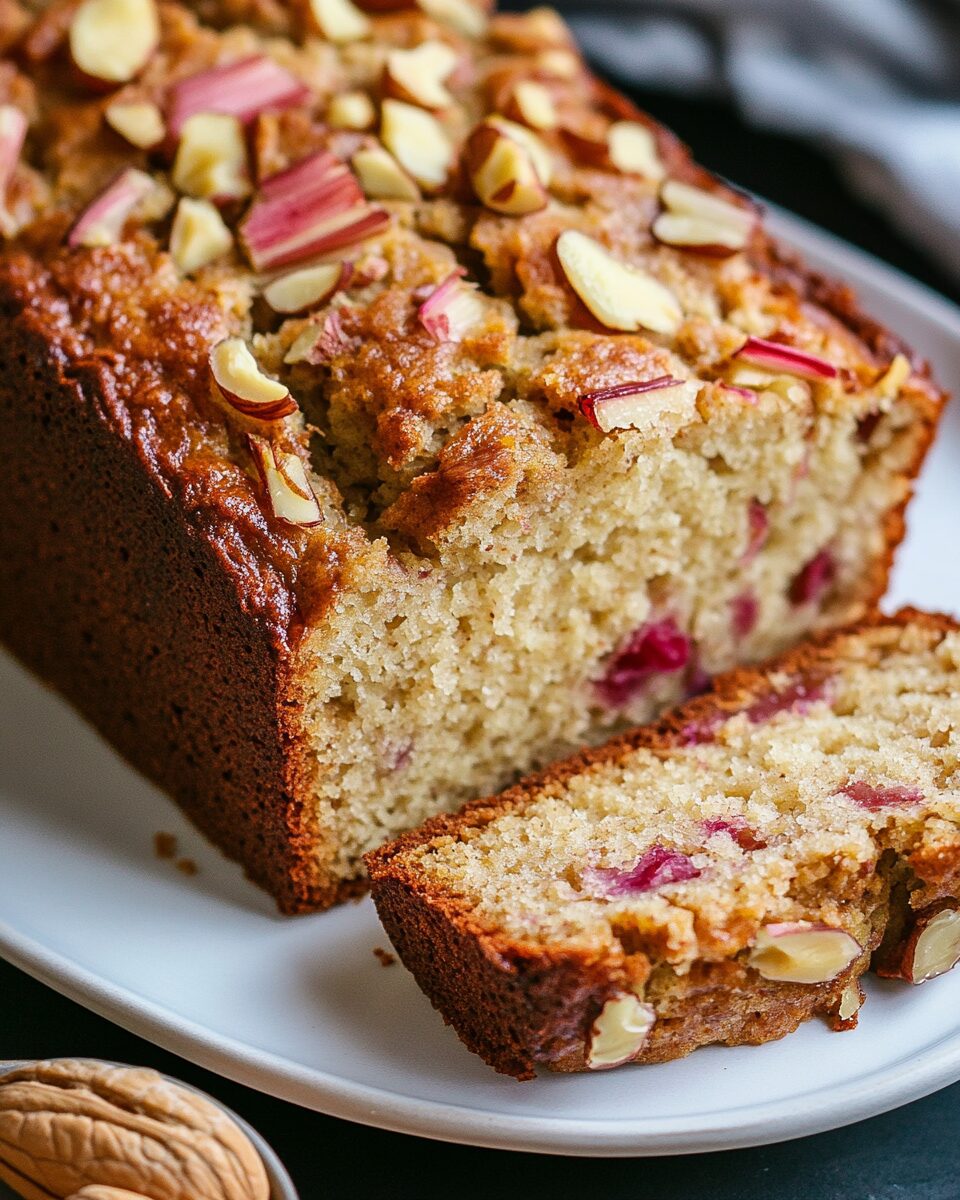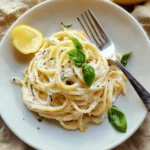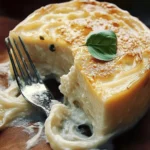This moist rhubarb bread is a treasured family favorite, known for its soft texture and sweet-tart flavor. It’s the perfect way to use fresh rhubarb during the season and makes a delicious snack or breakfast treat. The cinnamon sugar topping adds a delightful crunch that complements the tender crumb of the bread.
FULL RECIPE
Ingredients:
- 1½ cups brown sugar
- ⅔ cup vegetable oil
- 1 egg
- 1 cup buttermilk
- 1 teaspoon vanilla extract
- 2½ cups all-purpose flour
- 1 teaspoon baking soda
- ½ teaspoon salt
- 1½ cups finely chopped rhubarb
- ½ cup chopped walnuts or pecans (optional)
- ¼ cup granulated sugar (for topping)
- 1 teaspoon ground cinnamon (for topping)
Directions
- Preheat oven to 350°F (175°C). Grease two 9×5-inch loaf pans or line with parchment paper.
- In a large mixing bowl, combine brown sugar and vegetable oil until smooth.
- Beat in the egg, then stir in buttermilk and vanilla extract.
- In a separate bowl, whisk together flour, baking soda, and salt.
- Gradually stir the dry ingredients into the wet mixture until just combined.
- Fold in chopped rhubarb and nuts if using.
- Divide the batter evenly between the prepared pans.
- Mix granulated sugar and cinnamon together, then sprinkle evenly over the tops of the loaves.
- Bake for 50–60 minutes, or until a toothpick inserted into the center comes out clean.
- Allow to cool in the pans for 10 minutes before transferring to a wire rack to cool completely.
Nutritional Information
- Calories: 180
- Fat: 7g
- Carbohydrates: 28g
- Sugar: 16g
- Fiber: 1g
- Protein: 2g
History and Origins of Rhubarb Bread
Rhubarb bread has roots in traditional American and European baking, where rhubarb was often used in pies and desserts due to its tart flavor and seasonal availability. Its use in bread reflects a clever way to incorporate this unique vegetable into everyday meals, especially when fresh rhubarb was plentiful in spring and early summer. This adaptation of rhubarb into quick breads allowed families to enjoy its flavor beyond just desserts.
Seasonality of Rhubarb
Rhubarb is a spring vegetable, typically harvested from late April through June. Its bright red stalks and tart flavor make it a seasonal highlight, perfect for baking during this time. Using fresh rhubarb ensures the best flavor and texture for the bread, although frozen rhubarb can be a suitable alternative when fresh isn’t available.
Flavor Profile
The flavor of rhubarb bread balances sweet and tart beautifully. The natural acidity of the rhubarb contrasts with the sweetness of the sugar and the warmth of cinnamon in the topping, creating a complex and satisfying taste experience. This bread is not overly sweet, which makes it versatile for different times of the day.
Texture and Moisture
This recipe yields a moist, tender crumb thanks to the combination of oil and buttermilk, which help retain moisture during baking. The rhubarb itself adds pockets of juiciness, preventing the bread from drying out. The topping adds a slight crunch, providing a pleasant contrast to the soft interior.
Nutritional Benefits of Rhubarb
Rhubarb is low in calories and rich in vitamins K and C, as well as fiber. Incorporating it into bread adds nutritional value by contributing antioxidants and essential minerals. While the bread contains sugar and fat, the inclusion of rhubarb makes it a slightly healthier option compared to many other quick breads.
Substitutions and Variations
This bread can be adapted in several ways. You can substitute oil with melted butter for a richer flavor or use yogurt instead of buttermilk for a different tang. Nuts can be swapped for dried fruits like cranberries or raisins, and spices like nutmeg or ginger can complement the cinnamon topping.
Baking Tips for Success
To ensure the best outcome, measure flour carefully to avoid a dense loaf. Overmixing the batter can develop gluten and make the bread tough, so mix just until combined. Adding rhubarb last and folding gently helps distribute it evenly without breaking it down too much.
Storing and Shelf Life
Proper storage is important to maintain the bread’s moisture. It should be wrapped tightly in plastic wrap or stored in an airtight container at room temperature for up to three days. For longer storage, refrigeration or freezing is recommended, which preserves freshness for up to a month.
Freezing and Reheating
This bread freezes well and can be sliced before freezing for convenience. To reheat, thaw at room temperature and warm gently in a microwave or oven to bring back softness and freshness. Avoid overheating to prevent drying out the bread.
Serving Suggestions
Rhubarb bread can be enjoyed plain or with butter, cream cheese, or fruit preserves. It pairs well with a hot cup of tea or coffee for breakfast or an afternoon snack. The subtle tartness also complements mild cheeses for a more savory twist.
Health Considerations
While this bread is delicious, those watching sugar intake should be mindful of the sugar content, especially in the topping. Nuts add healthy fats and protein but should be omitted for those with allergies. Using whole wheat flour can boost fiber content for a healthier variation.
Cultural Significance
In many families, rhubarb bread carries sentimental value, often passed down through generations as a staple springtime treat. It represents resourcefulness and tradition, celebrating the changing seasons with simple homemade baking.
How Rhubarb Affects Baking Chemistry
The acidity in rhubarb reacts with baking soda, which helps leaven the bread and create a light texture. This natural acidity also helps balance the sweetness, preventing the bread from becoming cloying.
Why Buttermilk Is Used
Buttermilk adds acidity, which not only reacts with baking soda for rise but also tenderizes the gluten in the flour, resulting in a softer bread. Its slight tang enhances the flavor and complements the tartness of rhubarb.
The Role of Oil
Using oil instead of butter contributes to the moistness of the bread and keeps it softer for longer periods. Oil coats the flour proteins more thoroughly, inhibiting gluten formation and giving a tender crumb.
Importance of Cinnamon Sugar Topping
The cinnamon sugar topping adds texture contrast and a burst of warm spice that enhances the bread’s flavor profile. It caramelizes during baking, forming a thin crunchy crust that makes each bite more interesting.
Pairing Rhubarb Bread with Beverages
This bread pairs excellently with mild teas such as chamomile or green tea, as well as coffee and light milk-based drinks like lattes. The tartness balances sweet or creamy beverages, making it a perfect accompaniment.
Common Mistakes and How to Avoid Them
Overmixing the batter is a common error that can lead to a tough texture. Not greasing the pans well may cause sticking. Also, underbaking can result in a gummy center, so testing with a toothpick is essential.
Adapting for Dietary Restrictions
For gluten-free diets, using a gluten-free flour blend is possible though texture may vary. Vegan versions can substitute the egg with flax or chia egg and use plant-based milk with vinegar as a buttermilk substitute.
Using Rhubarb Beyond Bread
Rhubarb’s versatility extends beyond bread into pies, crisps, jams, and sauces. Its tartness balances sweeter ingredients well and can be combined with fruits like strawberries for more complex flavors.
Conclusion
Moist rhubarb bread is a delightful seasonal treat that combines tradition, flavor, and texture in one loaf. Its balance of sweet and tart, complemented by a crunchy cinnamon sugar topping, makes it a versatile option for breakfast, snacks, or dessert. With simple ingredients and straightforward preparation, it offers a way to enjoy fresh rhubarb in a comforting and nourishing form. Whether shared among family or served at gatherings, this bread celebrates the joy of home baking and seasonal ingredients, encouraging creativity and adaptation to personal tastes and dietary needs. Its rich history and satisfying taste continue to make it a beloved recipe that brings warmth and connection to the table year after year.






